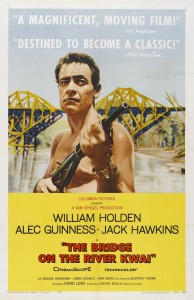 A turning point in David Lean’s career and the first of his big-budget, large-scale epic movies, “The Bridge on the River Kwai” swept most of the Oscars in 1957.
A turning point in David Lean’s career and the first of his big-budget, large-scale epic movies, “The Bridge on the River Kwai” swept most of the Oscars in 1957. Set during WWII, the prison drama is rich in characterization and marked by an ironic and ambiguous point of view, here in the manner in which it presents the conflict between Colonel Nicholson (Alec Guinness), a rigid British officer committed to the military code of integrity at all costs, the Japanese commander of the prisoners’ war camp (Sessue Hayakawa), and the American man of action (William Holden), who at first seems to be just a cowardly wise-guy.
Through these multi-nuanced individual characters, we also get a poignant look at the respective national cultures of which they are both products and victims. Hence, the construction of the bridge bears different meanings for these men. At the end, when the Colonel dies by falling on the detonator that destroys the bridge, the irony of the story becomes explicitly stinging.
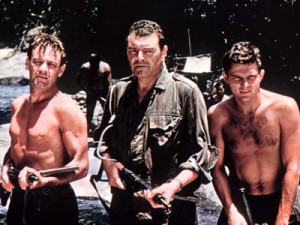 “Bridge on the River Kwai” is compelling as a psychological study of character, suspense, action, and a visual epic. As the critic Ivan Butler noted, “Bridge” is one of those rare pictures that satisfy audiences emotionally, cerebrally, and aesthetically.
“Bridge on the River Kwai” is compelling as a psychological study of character, suspense, action, and a visual epic. As the critic Ivan Butler noted, “Bridge” is one of those rare pictures that satisfy audiences emotionally, cerebrally, and aesthetically.
Based on fact, the film is still one of the finest and most exciting war films in general and prison dramas in particular.
Unacharacteristically of its times, “Bridge on the River Kwai” is more morally ambivalent and complex than most WWII pictures. If nothing else, the film illustrates the contradictions in the phrase “civilized warfare.” Perhaps for the first time in a Western film, the Japanese got to play a role that was not a clichéd villain.
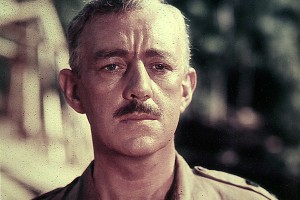 Michael Wilson and Carl Foreman did a good job at adapting Piere Boulle’s book to the screen, retaining much of his tough and terse dialogue, even if they departed from some of the facts. However, the writers were denied screenwriting credit due to blacklisting problems. But in 1996, the Writers Guild of America officially restored their names.
Michael Wilson and Carl Foreman did a good job at adapting Piere Boulle’s book to the screen, retaining much of his tough and terse dialogue, even if they departed from some of the facts. However, the writers were denied screenwriting credit due to blacklisting problems. But in 1996, the Writers Guild of America officially restored their names.
Alec Guinness, Sessue Hayakawa, and particularly William Holden deliver masterful performances.
A Blockbuster
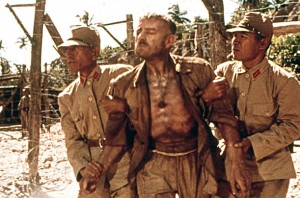 In 1966, when the movie played on American TV for the first time, it attracted 60 million viewers, the biggest TV audience for any show to date.
In 1966, when the movie played on American TV for the first time, it attracted 60 million viewers, the biggest TV audience for any show to date.
Oscar Alert
Nominated for eight Oscars, “Bridge on the River Kwai” won seven:
Picture Director: David Lean Actor: Alec Guinness Screenplay (Adapted) Pierre Boulle, Michael Wilson, Carl Foreman. Cinematography: Jack Hildyard Editing: Peter Taylor Score: Malcolm Arnold
The only category in which the movie lost was the Supporting Actor (Sessue Hayakawa), which in 1957, went to Red Buttons for “Sayonara.”
Director Alert
After this movie, Lean made four more pictures: the stunning epic “Lawrence of Arabia,” which swept the 1962 Oscars, “Doctor Zhivago,” the disappointing “Ryan’s Daughter” 1970) and the wonderful “A Passage to India” (1984), which became his swan song; Lean died in 1991.
Oscar Context
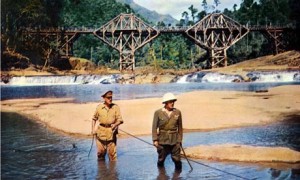 In 1957, “Bridge” was not the most nominated picture. That honored was claimed by “Sayonara,” with 10 nominations, and “Peyton Place,” with 9. The other two nominees were courtroom dramas: Sidney Lumet’s brilliant feature debut, “Twelve Angry Men” and Billy Wilder’s “Witness for the Prosecution.”
In 1957, “Bridge” was not the most nominated picture. That honored was claimed by “Sayonara,” with 10 nominations, and “Peyton Place,” with 9. The other two nominees were courtroom dramas: Sidney Lumet’s brilliant feature debut, “Twelve Angry Men” and Billy Wilder’s “Witness for the Prosecution.”
Three of the Best Picture nominees, “Peyton Place,” “Twelve Angry Men,” and “Witness for the Prosecution” didn’t win any awards.
Detailed Scenario
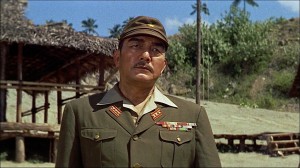 In World War II, British prisoners arrive at a Japanese prison camp in west Burma. Japanese Commandant Colonel Saito (Sessue Hayakawa) decides that all prisoners, regardless of rank, will work on the construction of a railroad bridge over the River Kwai. Senior British officer Lieutenant Colonel Nicholson (Alec Guinness) reminds Saito that the Geneva Conventions exempt officers from manual labor.
In World War II, British prisoners arrive at a Japanese prison camp in west Burma. Japanese Commandant Colonel Saito (Sessue Hayakawa) decides that all prisoners, regardless of rank, will work on the construction of a railroad bridge over the River Kwai. Senior British officer Lieutenant Colonel Nicholson (Alec Guinness) reminds Saito that the Geneva Conventions exempt officers from manual labor.
Nicholson orders his officers to remain behind when the enlisted men are sent off to work. Saito slaps him across the face with his copy of conventions, but Nicholson refuses to back down. When Major Clipton (James Donald), the British medical officer, intervenes, Saito leaves the officers standing all day in the tropical heat. The officers are punished while Nicholson is beaten and then locked in an iron box, known as the “oven.”
The prisoners work as little as possible, sabotaging whatever they can. If Saito fails to meet his deadline, he would be obliged to commit ritual suicide. Desperate, Saito uses the anniversary of Japan’s victory in the Russian-Japanese War as excuse to save face, announcing general amnesty, and releasing Nicholson and officers.
Inspecting the project, Nicholson is shocked by the poor job done by his men. He orders Captain Reeves (Peter Williams) and Major Hughes (John Boxer) to build a proper bridge, despite its military value to the Japanese, for the sake of maintaining morale. As the Japanese engineers had chosen a poor site, the original construction is abandoned and a new one begins.
Three prisoners try to escape, and two are shot dead, but U.S. Navy Lieutenant Commander Shears (William Holden), gets away, although badly wounded. He stumbles into a village, and the residents help him escape by boat.
Shears is the hospital in Ceylon, when British Major Warden (Jack Hawkins) asks him to volunteer for a commando mission to destroy the bridge before it’s completed. Shears reveals that he is not an officer at all; he switched uniforms with a dead officer as a ploy for better treatment. Faced with being charged with impersonating an officer, Shears volunteers.
Nicholson drives his men to complete the bridge on time. For him, its completion exemplifies the ingenuity and hard work of the British Army. When he asks that their Japanese counterparts join in, Saito replies that he has already given the order.
The commandos parachute in and one man is killed. Warden, wounded in encounter with Japanese patrol, has to be carried on a litter. He, Shears, and Canadian Lieutenant Joyce (Geoffrey Horne) reach the river with the assistance of Siamese women bearers and village chief, Khun Yai. In darkness, Shears and Joyce plant explosives on the bridge towers below the water line.
A train carrying soldiers and dignitaries is scheduled to be the first to cross the bridge, and Warden waits to destroy both. However, the commandos are horrified to see that the water level has dropped, exposing the wire connecting the explosives to the detonator. Making final inspection, Nicholson spots the wire and informs Saito.
Madness! Madness!
Joyce, manning the detonator, stabs Saito to death. Aghast, Nicholson yells for help, while attempting to stop Joyce from reaching the detonator. When Joyce is shot dead by the Japanese, Shears swims across the river, but is fatally wounded as he reaches Nicholson. Recognizing the dying Shears, Nicholson exclaims, “What have I done?” Warden fires his mortar, mortally wounding Nicholson. The dazed colonel stumbles towards the detonator and collapses on the plunger, in time to blow up the bridge and send the train into the river. Witnessing the carnage, Clipton shakes his head uttering, “Madness!… Madness!”
Cast
William Holden as Shears (Lieutenant Commander/Seaman, 2nd Class/Major)
Alec Guinness as Lieutenant Colonel Nicholson
Jack Hawkins as Major Warden
Sessue Hayakawa as Colonel Saito
James Donald as Major Clipton
Geoffrey Horne as Lieutenant Joyce
André Morell as Colonel Hornsby
Peter Williams as Captain Reeves
John Boxer as Major Hughes
Percy Herbert as Private Grogan
Harold Goodwin as Private Baker










